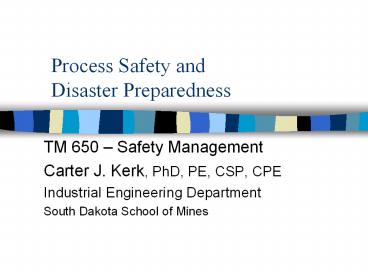Process Safety and Disaster Preparedness - PowerPoint PPT Presentation
Title:
Process Safety and Disaster Preparedness
Description:
Bhopal Disaster (www.bhopal.com) December 3, 1984, Bhopal, India ... source and exploded with the force of 2.4 tons of TNT and then subsequent fire ... – PowerPoint PPT presentation
Number of Views:191
Avg rating:3.0/5.0
Title: Process Safety and Disaster Preparedness
1
Process Safety andDisaster Preparedness
- TM 650 Safety Management
- Carter J. Kerk, PhD, PE, CSP, CPE
- Industrial Engineering Department
- South Dakota School of Mines
2
Reading Assignment
- Chapter 6, Asfahl
3
Process Safety Standard, 1992
- 29 CFR 1910.119
- 1 of OSHA General Industry citations address
this subject - Motivation (see course website)
- Union Carbide, Bhopal, India, 1984
- Phillips Petrochemical, Pasadena, Texas, 1989
- Purpose
- Preventing or minimizing the consequences of
catastrophic releases of toxic, reactive,
flammable, or explosive chemicals. These releases
may result in toxic, fire or explosion hazards.
4
Bhopal Disaster (www.bhopal.com)
- December 3, 1984, Bhopal, India
- 3800 killed, 40 permanently disabled, 2800
partially disabled - Union Carbide India Limited plant
- Methyl isocyanate (MIC, used to make pesticide
and herbicide) gas leaked into atmosphere,
killing and disabling thousands as they slept - Cause A large volume of water entered the MIC
tank, causing a chemical reaction forcing the
release valve to open and the gas to leak - Questions remain Was it an accident or
deliberate?
5
Phillips Petrochemical Disaster
- October 23, 1989, Pasadena, Texas
- 24 killed, 314 injured, 750M facility damage
- Polyethylene (plastic used to make milk
containers) - Cause Subcontractor maintenance crews using poor
lockout practices caused escape of process gas
(isobutane, ethylene, hexene, hydrogen) which
traveled to an ignition source and exploded with
the force of 2.4 tons of TNT and then subsequent
fire
6
29 CFR 1910.119
- Appendix A (Asfahl Appendix E)
- list of highly hazardous chemical, toxics, and
reactives - Appendix B (Asfahl Figure 6-1, 6-2)
- OSHA wants either a block flow diagram or a
simplified process flow diagram - Appendix C
- compliance guidelines
7
Develop an Information Database
- Compile info on
- highly hazardous chemicals used or produced
- equipment used
- technology of the process
- From MSDS and other sources
- See Case Study 6.1
8
Process Information Before an analysis of a
process can begin, the employer must compile
information on highly hazardous chemical to be
used or produced, the equipment to be used, and
the technology of the process. Potential sources
of information include the MSDS, chemical
dictionaries and reference manuals, and the NIOSH
Registry of Toxic Effects of Chemical Substances
(http//www.cdc.gov/niosh/rtecs/RTECSaccess.html).
Case Study 6.1 shows how published data can be
used to provide the data necessary for analysis
of hazardous processes. Also provide process
chemistry data, maximum intended inventory, and
safe upper and lower limits for temperatures,
pressures, flows, or compositions.
9
Note CAS Chemical Abstract Service number.
TQ Threshold (minimum) quantity in pounds
(amount necessary to be covered by this standard).
10
Document the Processes
- Use block flow diagrams or process flow diagrams
- where possible include flow rates, stream
composition, temperatures, pressures, etc. - include engineering details
- materials of construction, piping and
instrumentation diagrams, relief systems,
ventilation, interlocks, detection and
suppression systems, etc.
11
(No Transcript)
12
(No Transcript)
13
Is this only for the petrochemical industry??
- No, OSHA defines process more broadly
- poultry processor using chlorine for
refrigeration - metal processing industries using plating
chemicals (again see Text Appendix E)
14
Process Analysis
- What can go wrong?
- How to react?
- What-If Analysis
- fault-tree analysis (FTA)
- failure modes and effects analysis (FMEA)
- Analysis must be updated every 5 yrs
- Document and record analysis
15
Operating Procedures
- After process info has been gathered and
analyzed, develop effective operating procedures - Establish procedures for different modes
- normal operations
- temporary operations
- emergency operations
16
Training Programs
- Initial training for new operators and new
operations - Refresher training, lt 3 years
- Verification or testing
- Documentation
17
Contractors
- Contracted labor is a growing trend
- Prime employer is responsible for operations and
conduct of contract employees - Examine contractor safety records prior to
contract - Maintain injury/illness log on contract employees
18
Acts of Terrorism
- The terrorist attacks September 11, 2001 on the
World Trade Center and the Pentagon, forever
changed the challenges for Process Safety - We now add terrorist attacks to our concerns for
Disaster Preparedness - Many safety professionals have now had this
concern added to their responsibilities
19
Terrorist Disaster Preparedness
- Limit facility access
- Parking lot design and location
- Landscaping changes to protect buildings
- Concrete barricades to limit approaches and
access - Incident management aspects
- How to protect workers and volunteers after an
attack? - Training on use of equipment and PPE
- Have a company policy and plan!
20
Workplace Violence
- Increasing incidences of workplace shootings (and
school shootings) - Homocide is 4th leading cause of fatal
occupational injury in the US. - 551 workplace homicides in 2004
- http//www.osha.gov/SLTC/workplaceviolence/index.h
tml - Have a company policy and plan!
21
HW10 Chapter 6 Questions
- Exercises Study Questions, 130-131
- 1-25, odds
- Research Exercises
- Review the information posted on the website
concerning the Bhopal (1984) and Phillips (1989)
tragedies - Check out more details about these tragedies on
the internet - Write about what there is to learn about these
historical events for todays safety managers and
technical managers






























